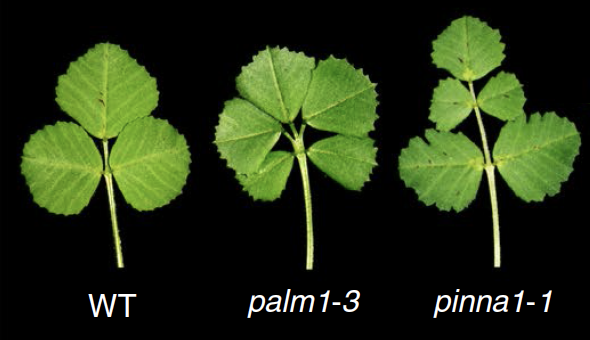博文
Nature Plants:蒺藜苜蓿中调控复叶形态发生的分子框架
||
A molecular framework underlying the compound leaf pattern of Medicago truncatula
第一作者:Liangliang He
通讯作者:Jianghua Chen
Abstract
背景回顾:Compound leaves show more complex patterns than simple leaves, and this is mainly because of a specific morphogenetic process (leaflet initiation and arrangement) that occurs during their development.
提出问题:How the relevant morphogenetic activity is established and modulated to form a proper pattern of leaflets is a central question.
主要发现:Here we show that the trifoliate leaf pattern of the model leguminous plant Medicago truncatula is controlled by the BEL1-like homeodomain protein PINNATE-LIKE PENTAFOLIATA1 (PINNA1).
结果:We identify PINNA1 as a determinacy factor during leaf morphogenesis that directly represses transcription of the LEAFY (LFY) orthologue SINGLE LEAFLET1 (SGL1), which encodes an indeterminacy factor key to the morphogenetic activity maintenance. PINNA1 functions alone in the terminal leaflet region and synergizes with another determinacy factor, the C2H2 zinc finger protein PALMATE-LIKE PENTAFOLIATA1 (PALM1), in the lateral leaflet regions to define the spatiotemporal expression of SGL1, leading to an elaborate control of morphogenetic activity.
结论:This study reveals a framework for trifoliate leaf-pattern formation and sheds light on mechanisms generating diverse leaf forms.
摘 要
复叶要比单叶表现出更加复杂的模式,而这主要是由于复叶在发育过程中存在一个特异的形态发生过程,即小叶的起始和排列。其中的核心问题是复叶发育过程中,相关的形态发生活性是如何建立的,以及又是如何被精确调控的,从而正确形成小叶。本文中,作者的研究显示豆科模式之物蒺藜苜蓿(Medicago truncatula)的三叶形成是由BEL1-like同源结构域蛋白PINNA1控制的。作者发现在叶片的形态发生过程中,PINNA1能够直接抑制LEAFY同源基因SGL1的表达,而该基因编码一个作用于形态发生活性维持的不确定因素。PINNA1在小叶末端区域独自发挥作用,而在小叶外侧区域会与C2H2锌指蛋白PALM1一起发挥作用,从而调控SGL1基因的时空表达模式,最终作用于复叶形态发生的精确控制。本文的研究揭示了一个作用于三叶模式形成的遗传框架,并且为植物叶片形态多样性的遗传机制研究提供了新的视野。
唠~唠
作者在前期的研究中筛选到了一个palmate-like pentafoliata1 (palm1)苜蓿突变体(Chen et al., 2010, PNAS),野生型的三叶变为掌状五叶(下图)。进一步的研究分析发现该突变体的突变基因为一个C2H2锌指蛋白PALM1,该蛋白能够抑制LEAFY同源基因SGL1的转录,从而影响苜蓿的复叶发育。本文中,作者为了鉴定其它参与苜蓿复叶发育的调控子,通过Tnt1逆转座子插入突变筛到了一个pinnate-like pentafoliata1-1(pinna1-1),该突变体特征为原本的三叶变为了羽状五叶(下图)。进一步的研究发现显示该突变体的突变基因是一个BLH蛋白PINNA1。

原位杂交试验显示PINNA1基因主要在顶生小叶和侧生小叶原基中表达,而在SAM中不表达。亚细胞定位显示PINNA1蛋白主要定位于细胞核,说明其是一个转录调控因子。接着,作者研究了其与SGL1以及PALM1之间的关系,最终提出了一个model(下图)。
Fig. 6 | Model for PINNA1, PALM1 and SGL1 action in the pattern formation of compound leaf in M. truncatula. a, SGL1 facilitates the initiation of LL primordia (green arrows). PINNA1 acts alone in the TL primordium, whereas PALM1 has a master regulator role (bold line) and PINNA1 has a secondary regulator role in the LL primordia, in repression of SGL1 expression. b, Summary of mature-leaf phenotype results from loss of gene functions (labelled arrows). Terminal and lateral leaflet regions are coloured in grey and purple, respectively.
通讯作者
**陈江华**
个人简介:
1996-2000年,武汉大学,学士;
2000-2006年,中科院上海植生所,博士;
2006-2013年,美国塞缪尔·诺贝基金会,博后。
研究方向:
1. 豆科植物叶片运动的信号转导途径的研究;
2. 重要农作物的基因功能研究及分子辅助育种;
3. 云南豆科中药材中活性天然产物的次生代谢生物合成和基因工程研究。
doi: 10.1038/s41477-020-0642-2
Journal: Nature Plants
Published date: May 11, 2020
p.s. 叶片发育、形态发生相关研究链接:
https://blog.sciencenet.cn/blog-3158122-1233640.html
上一篇:Nature Plants:苔藓植物地钱中的最小化生长素响应系统
下一篇:Plant Communications:植物中的HY5并不是shoot-to-root的移动蛋白
全部作者的其他最新博文
- • Plant Physiology:CsMADS3促进柑果中的叶绿素降解和类胡萝卜素合成(华中农业大学)
- • Molecular Plant:LBD11-ROS反馈调节作用于拟南芥的维管形成层增殖和次生生长(浦项科技大学)
- • Science Advances:根结线虫通过调控植物的CLE3-CLV1模块,促进侵染进程(日本熊本大学)
- • Nature Communications:油菜素内酯参与植物营养生长期转变的分子机制解析(浙江农林大学)
- • Current Biology:光合作用产生的蔗糖驱动侧根“生物钟”(德国弗莱堡大学)
- • PNAS:花同源异型基因在叶中被抑制、花中被激活的分子机制(南卡罗来纳大学)